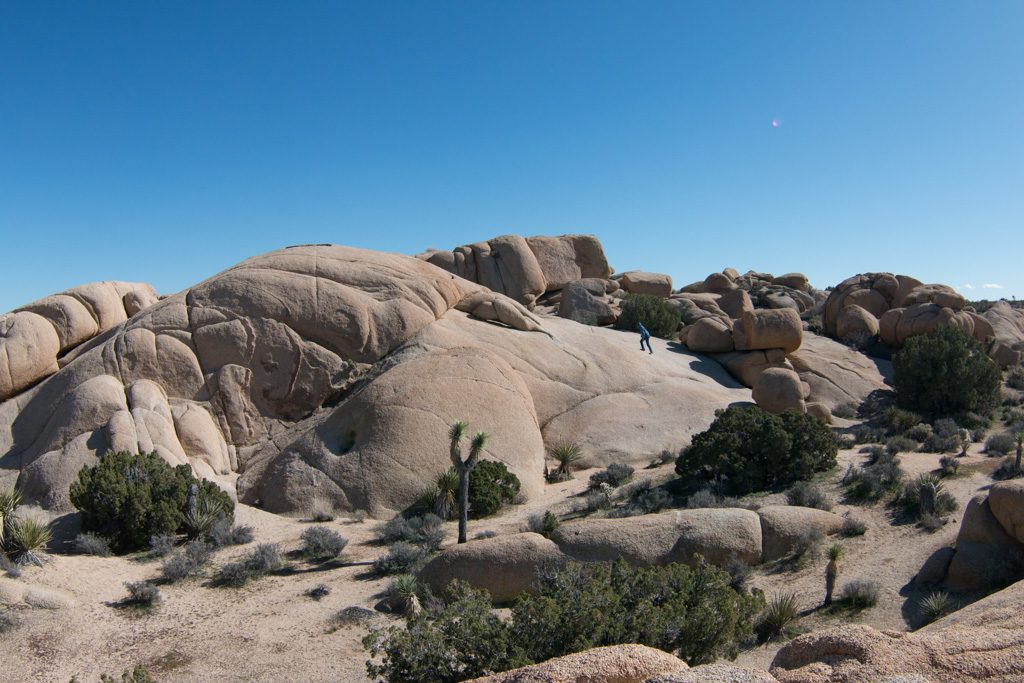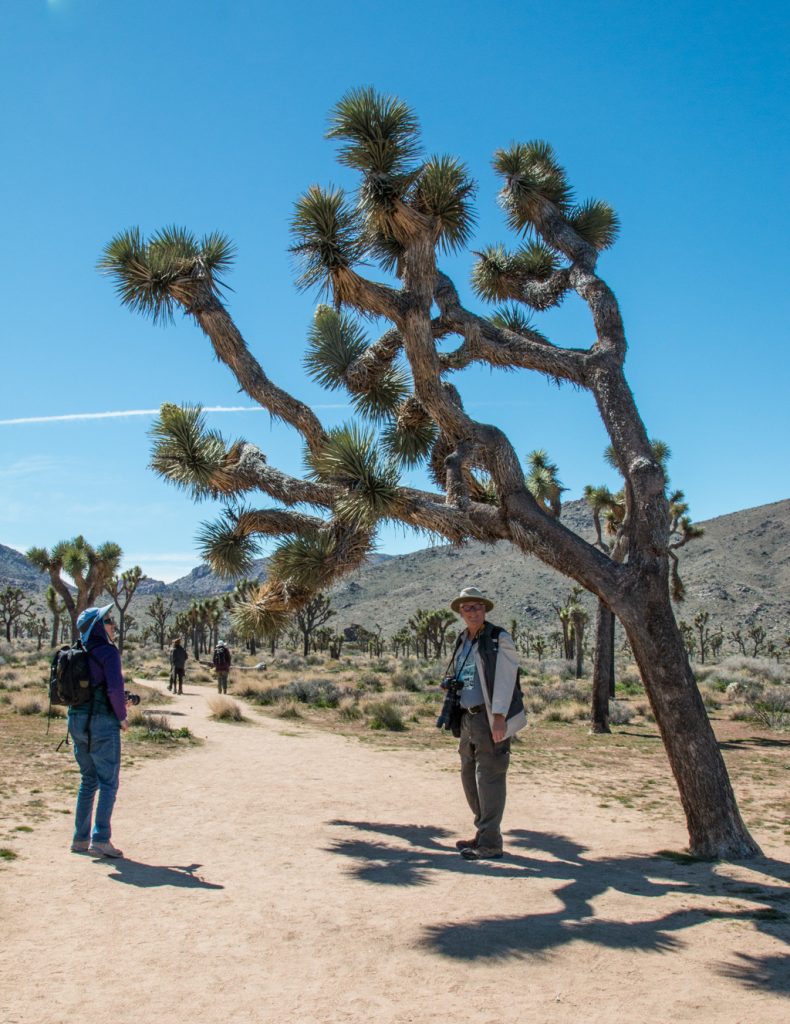
Joshua Tree National Park is a great playground with varied terrain; large portions are covered with myriad granite structures. Some are weathered and rounded, with large smooth (-ish) boulders in the area. Some are jagged with rubble scree at their base instead of the boulders. The geology of the area is complex. From what I’m reading, some of that difference depends on the depth of the magma that was the source. The crystalline structure of much of the granite is quite large and rough; this draws rock climbers from all around the world. We saw many there.
We traveled to Joshua Tree NP with friends James and Gloria, whom we met first at the Grand Design RV Owners’ rally back in January. James is a ham radio operator, so we also went to the Quartzfest gathering together.
The park has two very different ecosystems, the Mojave desert and the Colorado desert; they are distinguished by elevation with the Mojave much higher than the Colorado. Vegetation and animals are different between the two, with the higher Mojave being both wetter and more vegetated, and the Colorado more arid. We spent our first two days in the Mojave desert on the north side of the park, which contains the majority of the Joshua Trees.
The northern part, Mojave desert
The scale of some of the rock formations is hard to get across in pictures, until you see some with people in them. Can you find the four climbers in the picture below? Hint: one of them is the climber in the picture above.




Joshua trees
Have you ever looked at the trees in Dr. Seuss’ books, such as the cover of The Lorax? It is said that the Joshua trees are the inspiration for his Truffula trees; he lived and worked in the southern California area.
They are oddly shaped! Twisty and gnarly. But oh, so cool to look at.


Technically, Joshua Trees aren’t trees, but related to the agave. They are long lived, typically living several hundred years. The visitor center was selling Joshua Tree seeds and a little, itty-bitty pot to plant them in. Might work, if the person buying them can wait a few hundred years!
We were very lucky to be there while the Joshua Trees were blooming. There are several fairly distinct stages to the bloom cycle.




A part of the Mojave desert portion of the park holds a Joshua tree forest. It isn’t a dense forest, but there sure are a lot of Joshua trees!

A few more pictures of scenes from the Mojave part of the park that I just found visually magnetic.


Life in the desert is hard. Even for the cholla (CHOY-ah) cacti. The lace-like skeleton of the cholla is interesting.


But life tries hard to find a foothold! (“roothold”?)
The transition zone
Where the two deserts meet is called the “transition zone.” Overlooking the transition zone is the highest point in the park reachable by vehicle, Keys View.

Although the transition zone contains animals from both sections, we saw very little wildlife in the park at all, just a few lizards. We’re just as glad that we didn’t see any of the rattlesnakes which are starting to come out as the days grow warmer. (People camping near us in Quartzsite have seen them!)
The Colorado desert
It is possible to drive from the northern part of the park to the southern part through the park but it is an approximately two hour drive due to the speed limit in the park. We opted to pick up our stakes and bring our rigs to the southern entrance, going around the west side of the park. Part of the reason for moving instead of just doing the southern part as a day trip from the north is that this brought us that much closer to “home,” i.e., Quartzsite.
Going around the park that way on I-8 (or, “the 8,” out here) one comes across this.

If you’re hauling an RV as we were, you better hope it isn’t a windy day! But we’re really glad to see large wind and solar farms. This one went on for miles; it is the largest we had seen since Texas.
There is a BLM dry camping area immediately outside the park at the southern entrance (the area abuts the park). This turned out to be one of the prettiest places we have ever camped, with desert flowers blooming right alongside our camper and all around us, and mountains in the background. We would go back there in a heartbeat!

The southern part of the park has few Joshua Trees. Being more arid, the main vegetation here is various types of cacti. The main draw there, especially this time of year, is the desert bloom—at least it was for us.
This has been an exceptional year for the bloom. We didn’t go to two highly reported areas, one near Tucson and one in Southern California where the authorities had to close a town of 60,000 people when 100,000 people tried to come photograph the flowers one Sunday.
But Joshua Tree was really pretty!









The Cholla Garden
“Be careful! They’ll jump out at you and attack you!” Gloria warned us as we were getting out of the car at the Cholla (CHOY-ah) Garden section of the park.

“Yeah. Ha ha ha ha.” That’s me, of course. (You’d think I would have learned by now…)

Cholla cacti spread by dropping small sections to the ground which then take root. The dropped sections are transported by passing animals, including those of the homo sapiens variety. See all those needles? Barbed!
I was walking through the garden being careful to not brush against cacti. Then the wind blew a small dropped section against my boot. Instantly about twenty needles were stuck in the leather (thank goodness that I wasn’t wearing sandals or even regular low shoes)! Did I mention that the needles are barbed? Trying to pull the needles out of my boot’s heavy leather simply resulted in them breaking off.

We really enjoyed our three days in JTNP. There is much more to do there, including several hikes we’d like to take. We’ll be back.
So closes another portion of our adventure. We wish you the best on your own adventure through life, whatever it may be!


Loved this update!!! The flowers were beautiful! So nice to see when it’s 23 and I’ve been snowmobiling all day in Rangeley, Maine!🤣
This entry in particular makes me wish that Vicki and I had had more tine with out Van Gogh trips. We did visit Joshua Tree NP on one of our eight honeymoon trips in 1998. BTW, this is the best time of year to see Death Vally NP. Recommendation: then drive up the beautiful US 395.
Pete & Vicki
Thst’s our plan as soon as our So Dakota license plates arrive.
I thought of Margaret as I scrolled through your photos of flowers. She would have loved seeing the striking beauty of the desert. I experienced a wonderful desert bloom many years ago on a trip from Southern California out to Arizona. I am glad you had such a great adventure.
Look again at the “Life tries to find a foothold” photo.
Do you see a rock formation in the shape of an ape’s head?
We are enjoying your blog!
I enjoyed your beautiful photos! Thank you so much for documenting your adventures.
We too loved our time at Joshua Tree. We had made reservations for the tour of the Keyes Ranch and it was fascinating. Also loved the hidden Valley loop hike. If you saw Roy Rodgers movies as a child then the rock formations were very familiar. The movies were filmed in this area.
You really happened to be in JT at a perfect time this year. I never saw any flowers blooming when I was there. I did some rock climbing when I was there,though. The rock formations are out of this world! As are the joshua trees themselves. It is really a fascinating place. I look forward to your photos from Death Valley.